How does a painting REALLY impact our day-to-day life?
This weekend I went to this amazing exhibition called “Building the Revolution: Soviet Art and Architecture 1915-1935”. And it was not the political argument that amazed me; I am not communist or socialist. The reason why this event was so interesting was because it showed through a very simple and clear way the power of artistic paintings. We love to see Monet’s beauty or Picasso’s boldness. But do we ever see how their work of art might affect our lives? How many times do we just go to a museum to tick one more item in our tourist’s list?
The exhibition presented some paintings and drawings from some important soviet artists from the post-revolution decades. Their challenge wasn’t a small one. Through their paintings they aimed to investigate new possibilities in order to build up a new society - The Soviet Nation. They were fully committed with the development of a new architecture. They understood that if the Soviet Union wanted a new culture, this implied new walls and new windows. A new way to understand the world, a new way to “frame” the world, a way to “create their own words” to describe the world. The old words were not enough anymore. And they knew that the instrument to get to new possibilities was art.
So, you are probably curious to understand what kind of drawings and paintings did they do to enable this big accomplishment. What kind of figure may construct a whole nation? Surprisingly, It was most geometric forms (triangles, rectangles, lines, etc.). Trough the juxtaposition, composition and inversion of those abstract geometric forms, they investigated 2D and 3D dimensions. But one could wonder, what the hell a triangle has anything to do with socialism?
El Lissitzky
Ivan Kudriashov
What we usually don’t get is that we are surrounded by those forms. We got so used to them, that we don’t realise that we think through them. A window is usually squared, a room is usually rectangular and a roof, triangular. Who has a circular living room? How does a circular living room fit our squared house? How does a circular living room fit our idea of home? Through rectangles, triangles, circles and lines, they were studying the “forms” of our everyday. And how those enabled some space and limited others.
It would be just paper… but just aside the painted canvas at the exhibition, you could see the photos of existing buildings. The ink became concrete. The lines became buildings. Real industries, houses, and clubs that were suppose to translate the values of a new society. The new values were chosen - equality, sociality, productivism, etc – and each wall should translate them, each corridor should take you in their direction: housing with mainly common areas so people would interact, public kitchens so the women wouldn’t be responsible for the housework, building’s facades that would be integrated with their functions. For this new society, with a new mind, circular buildings please…


Photos Richard Pare
Not every art is political and not every art is engaged with the construction of a whole new society. Not every art aims to contribute with architecture. That one did… But through this example we can clearly see how those simple rectangles drawn on the paper might drastically influence the kind of walls that we build to our lives and the kind of doors that we see to ourselves.
How do you draw a house? What about a person? A stickman? Is that what you really see? Or better, is that what you would like to see and draw? Could you go farther? What could you use instead of lines? Could you use rectangles? What kind of person would it be then? What kind of world would it constitute? Will you keep squared or try to go circle?
… Shall we look Picasso again?
Xx CBalt
For more information about the exhibition, visit: http://www.royalacademy.org.uk/exhibitions/building-the-revolution/
Images from the exhibition catalogue



Oi carol!!! adorei o post e a construção do texto!! realmente você me fez pensar no porque de triangulos, circulos e retangulos....
ReplyDeletecurioso que no construtivismo alemão e na bauhaus (amooo) o uso de formas geometricas simples e cores primárias também é marcante. Será que, na tentativa de construir uma nova arte (ou uma nova arquitetura, nova sociedade, etc) não é necessário fazer um back to basics? voltar para as formas mais simples que conhecemos?
Ao mesmo existe um fascínio pelas cores e formas simples... há algo cativante em um cubo perfeito? Tratando- se de arquitetura então, o cubo é uma certa mania e obsessão. Mas por que nos fascinamos por estas formas geométricas simples? será a beleza e a pureza da matemática? a tranquilidade das linhas retas e perfeitas? Ou será porque é o oposto das formas organicas da natureza? A justaposição do orgânico com o inorganico construido? ou simplesmente a simplicidade da forma?
algo curioso não?
bj bj bj
Acredita que vi uma exposição com a mesma proposta no Reina Sofia de Madrid? Só que não era sobre a arquitetura da revolução soviética, era sobre arte em geral, sendo que os artistas também criavam propaganda, roupas, etc. Eram de fato responsáveis pela criação e disseminação de uma cultura revolucionária. Me incomodou um pouco o fato de ser uma arte extremamente direcionada, aliada à uma ideologia política, sem espaço para contraposições, para o debate, não parecia haver uma democracia artística. Mas era bem interessante. =)
ReplyDeleteBesos!
Ótimo texto, Carol!
ReplyDeleteAcho que arte e arquitetura andam mesmo de mãos dadas.
E é por isso que a nossa música de hoje é sobre um pedreiro que virou uma obra de arte :)
http://www.youtube.com/watch?v=CGoSsT9EjaQ
Saudade. Beijos,
Sylvia Medeiros
adoreiii! :)
ReplyDelete